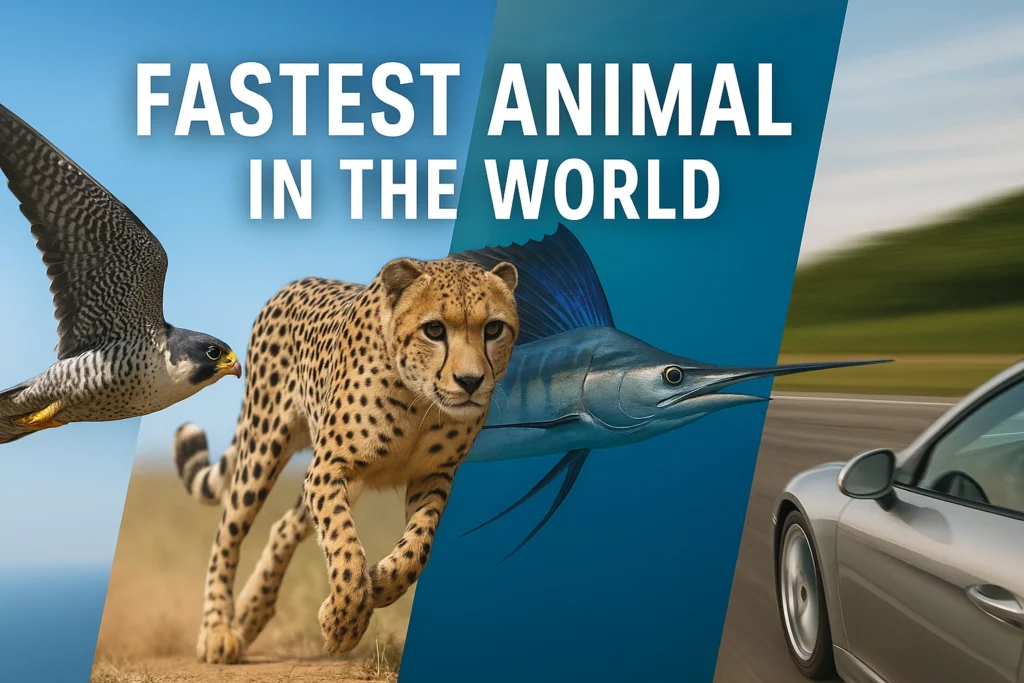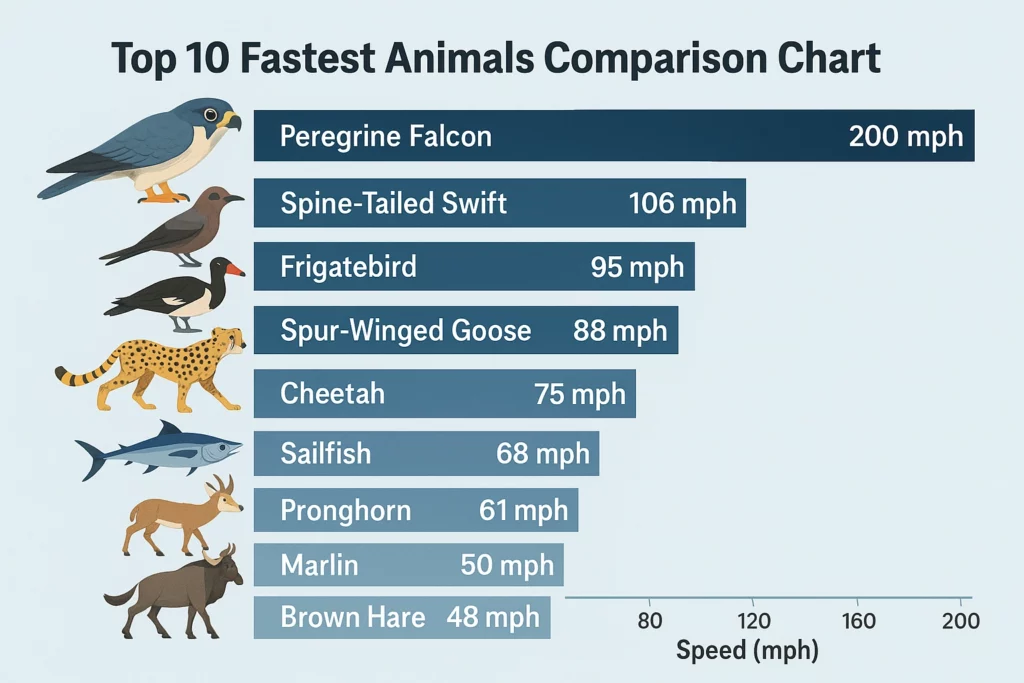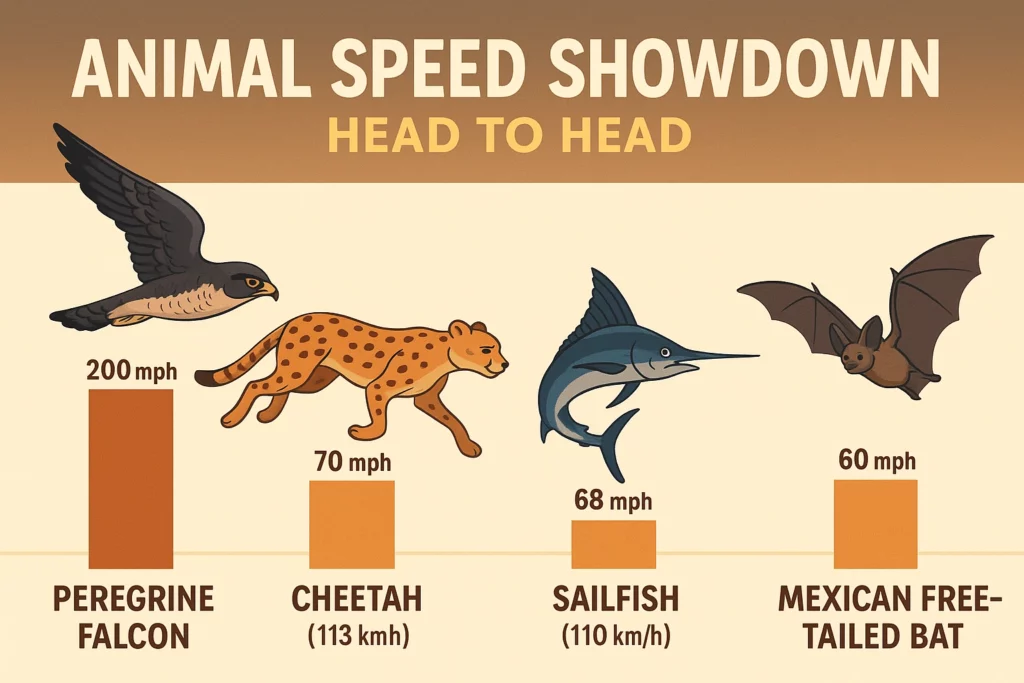
Have you ever wondered what is the fastest animal in the world? It’s a question that sparks curiosity, debates, and excitement among nature enthusiasts, animal lovers, and trivia buffs alike. Whether you’re fascinated by the incredible agility of a cheetah chasing its prey across the African savanna, or you’re amazed by a peregrine falcon diving faster than most cars can drive, nature never fails to astonish us with its remarkable speed records.
In this comprehensive and visually stunning guide, we’ll not only answer your burning questions—like “what is the fastest animal on earth?”—but we’ll also introduce you to the fascinating stories, adaptations, and secrets behind these speedsters of the animal kingdom.
You’ll explore detailed comparisons in our exciting Animal Speed Showdown section, uncover fascinating facts, and get crystal-clear visuals that illustrate exactly how these animals achieve such incredible velocities.
So, buckle up! Because whether you’re here to discover the top speeds of marine creatures, air masters, or land sprinters, this guide on the fastest animal in the world will give you an exhilarating, educational, and unforgettable ride through nature’s most incredible sprinters.
Ready to meet the fastest animals on Earth? Let’s dive right in!
Which Animal Takes the Crown?
Let’s get straight to the exciting answer first, and then we’ll dive deeper into details. If you’re asking “what is the fastest animal in the world”, the answer might surprise you. Many assume it’s the cheetah, renowned as the fastest land animal, reaching speeds up to 75 mph. However, the overall champion is actually found in the sky—the peregrine falcon, diving at breathtaking speeds of up to 242 mph!
But speed isn’t just impressive in the air or on land. Remarkable speed records also exist underwater. For instance, the sailfish dominates oceanic speeds, slicing through water at about 68 mph, outpacing many boats!
To give you a quick snapshot, here’s an overview of the top three fastest animals across air, land, and water:
- Air: Peregrine Falcon – 242 mph (fastest animal overall)
- Land: Cheetah – 75 mph
- Water: Sailfish – 68 mph
Intrigued to learn more about these incredible speed champions? In the upcoming sections, we’ll explore the detailed top 10 fastest animal in the world list, discover fascinating scientific explanations, and enjoy captivating head-to-head comparisons in our Animal Speed Showdown.
Top 10 Fastest Animal in the World: Rankings, Speeds & Fascinating Facts

Now that we’ve uncovered what is the fastest animal in the world, it’s time to dive deeper. Below, you’ll find the carefully curated and detailed list of the top 10 fastest animal in the world. Each entry provides fascinating facts that reveal how these animals have uniquely evolved to become nature’s ultimate sprinters.
The Ultimate Speed Champions Chart
| Rank | Animal | Top Speed | Habitat | Fascinating Fact |
| 1 | Peregrine Falcon | 242 mph | Air | Achieves fastest speeds by diving to catch prey mid-flight. |
| 2 | Golden Eagle | 200 mph | Air | Exceptional vision helps spot prey from over a mile away. |
| 3 | Brazilian Free-tailed Bat | 99 mph | Air | Fastest mammal in flight, covering incredible distances nightly. |
| 4 | Cheetah | 75 mph | Land | Can accelerate faster than most sports cars. |
| 5 | Sailfish | 68 mph | Water | Streamlined body built for unmatched underwater agility. |
| 6 | Pronghorn Antelope | 61 mph | Land | Built to outrun now-extinct predators from prehistoric eras. |
| 7 | Marlin | 50 mph | Water | Exceptional strength helps it swiftly navigate ocean currents. |
| 8 | Ostrich | 45 mph | Land | World’s fastest bird on land with powerful legs. |
| 9 | Greyhound Dog | 43 mph | Land | Bred specifically for racing, with incredible acceleration. |
| 10 | Blackbuck Antelope | 50 mph | Land | Known for sustained speed and extraordinary agility. |
Each animal in this table has earned its place through incredible evolutionary adaptations, enabling them to thrive in their unique environments. In the following section, we’ll put some of these speedsters head-to-head in our thrilling Animal Speed Showdown, providing you with entertaining comparisons you won’t want to miss.
Animal Speed Showdown: Head-to-Head Comparisons

Now that you’ve explored the top 10 fastest animal in the world, let’s take this excitement to another level. It’s time for an exhilarating animal speed showdown, featuring thrilling, head-to-head comparisons. Who will win when nature’s fastest sprinters compete?
Below, you’ll find carefully selected animal matchups along with their top recorded speeds and fascinating insights that reveal exactly why these incredible creatures are such masters of velocity.
Suggestion: Master French Conversations With 30+ Practical Avoir Phrases.
Speed Battle #1: Peregrine Falcon vs. Golden Eagle
- Winner: Peregrine Falcon
- Speeds: Peregrine Falcon (242 mph) vs. Golden Eagle (200 mph)
- Insight:
While the Golden Eagle’s speed is impressive, nothing matches the Peregrine Falcon’s astonishing 242 mph dive. Falcons achieve this with a specialized body shape, sharp wings, and extraordinary eyesight for pinpoint accuracy.
Speed Battle #2: Cheetah vs. Pronghorn Antelope
- Winner: Cheetah
- Speeds: Cheetah (75 mph) vs. Pronghorn Antelope (61 mph)
- Insight:
Though the Pronghorn is incredibly swift, capable of sustained speeds, the cheetah wins in a quick burst. The cheetah’s extraordinary acceleration, able to go from 0 to 60 mph in just three seconds, makes it the undisputed land-speed champion.
Speed Battle #3: Sailfish vs. Black Marlin
- Winner: Sailfish
- Speeds: Sailfish (68 mph) vs. Black Marlin (50 mph)
- Insight:
Sailfish take the crown with their streamlined bodies and elongated bills, specifically evolved to slice smoothly through ocean currents. This aerodynamic form allows them to achieve unmatched speeds underwater.
Speed Battle #4: Ostrich vs. Greyhound Dog
- Winner: Ostrich
- Speeds: Ostrich (45 mph) vs. Greyhound (43 mph)
- Insight:
Ostriches outpace even greyhound dogs with their powerful legs and impressive stride lengths of up to 16 feet per step. Their unique leg structure allows them to maintain high speeds over longer distances.
These fascinating matchups show us that speed isn’t just about numbers—it’s about evolution, adaptation, and survival. Nature crafts every speed champion with precision and purpose, equipping them to dominate their habitats.
In the next section, we’ll explore the incredible science behind animal speed, answering not only what is the fastest animal in the world, but also explaining why and how they achieve these remarkable speeds.
Behind the Speed: The Science Explained
Now that we’ve revealed the fascinating details behind the top 10 fastest animal in the world, it’s time to answer the deeper question: what is the fastest animal in the world doing differently to achieve such phenomenal speeds?
Let’s explore the captivating science and remarkable evolutionary adaptations behind nature’s fastest animals:
Muscle Structure: The Powerhouse Behind Speed
Fast animals, such as the cheetah and peregrine falcon, have evolved a specialized type of muscle fiber known as fast-twitch muscles. Unlike regular muscle fibers, these provide explosive bursts of speed, allowing a cheetah to accelerate faster than most high-performance sports cars.
- Example: A cheetah’s muscles enable it to accelerate from 0 to 60 mph in roughly three seconds, thanks to abundant fast-twitch muscle fibers.
Aerodynamics: Shaped for Speed
Animals like the peregrine falcon and sailfish owe their record-breaking velocities largely to exceptional aerodynamic adaptations. Their bodies have evolved specifically to minimize air and water resistance:
- Example: The peregrine falcon’s sharp, sleek wings and bullet-shaped body allow it to dive with minimal drag, effortlessly achieving its world-record speed of 242 mph.
- Example: The sailfish’s elongated body, sword-like bill, and retractable sail (dorsal fin) help reduce water drag, enabling smooth, lightning-fast underwater motion.
Energy and Metabolism: Fueling the Sprint
Achieving incredible speeds isn’t just about muscles and shape—it also requires immense energy. Animals with extreme speeds have evolved extraordinary metabolic systems to supply rapid energy bursts:
- Example: The pronghorn antelope has a uniquely efficient respiratory system and enhanced oxygen intake capabilities, helping it sustain top speeds over long distances.
Special Adaptations: Nature’s Unique Solutions
Nature crafts incredible solutions to challenging problems. Every animal in our top 10 fastest animal in the world list showcases unique biological adaptations suited precisely to its habitat and lifestyle:
- Example: Ostriches have evolved long, powerful legs that generate immense thrust, combined with specialized tendons to store and release energy efficiently, facilitating endurance at high speeds.
- Example: Brazilian free-tailed bats have extremely flexible wings and lightweight bones, allowing them to reach speeds nearly unimaginable for other mammals.
Understanding these intricate biological details deepens our appreciation of the extraordinary animals we share our planet with. Speed, after all, is not simply about numbers—it’s an evolutionary masterpiece crafted by millions of years of natural selection.
Next, we’ll bust some popular myths and misconceptions about animal speeds, delivering even more surprising facts and fascinating insights.
Related: Master 100+ Vegetable Names in French and Level Up Your Learning.
Fast Facts & Myths Busted
Now that you’ve explored the amazing science behind the speed of the top 10 fastest animal in the world, let’s have some fun busting popular myths and uncovering surprising truths about these incredible speedsters. Not everything you’ve heard about the fastest animal in the world is true—let’s separate fact from fiction!
Here are some common myths along with fascinating truths:
- Myth: “The cheetah is the fastest animal overall.”
- Truth: While the cheetah is indeed the fastest land animal at 75 mph, the overall fastest animal in the world is the peregrine falcon, diving at an astonishing 242 mph.
- Myth: “Speed is all about size and strength.”
- Truth: Animal speed is actually influenced heavily by body shape, muscle type, and adaptations like aerodynamics, rather than just size or brute strength. Small animals, like bats or falcons, can outpace larger creatures because of their specialized aerodynamic forms.
- Myth: “Fastest animals only live on land.”
- Truth: As you’ve seen from our top 10 fastest animal in the world list, animals achieve remarkable speeds in air (peregrine falcon), water (sailfish), and land (cheetah). Speed records span across multiple environments.
- Myth: “All birds fly at roughly similar speeds.”
- Truth: Bird speeds vary tremendously. The peregrine falcon’s diving speed of 242 mph dwarfs the average speed of most birds, which typically ranges from 20–50 mph. Specialized wing structure and diving techniques set speed records.
- Myth: “Animals with higher top speeds always win the race.”
- Truth: Peak speed alone doesn’t guarantee survival. For example, pronghorn antelopes run at lower speeds (61 mph) than cheetahs, but their endurance allows them to sustain these speeds for longer durations, often escaping predators.
By busting these myths, we appreciate even more deeply the fascinating complexity behind nature’s design of speed and agility.
In our final section, we’ll wrap things up by reflecting on these incredible animal athletes and what their phenomenal speed teaches us about the natural world.
You May Also Like: Add Fun to Your Spanish With These Cool Slang Expressions.
Frequently Asked Questions (FAQ)
1. What is the fastest animal in the world?
The fastest animal in the world is the peregrine falcon, reaching speeds of up to 242 mph (389 km/h) when diving to catch prey.
2. What is the fastest animal on earth (land animal)?
The cheetah holds the title for the fastest animal on land, reaching impressive speeds of up to 75 mph (120 km/h). Its incredible acceleration allows it to sprint from 0 to 60 mph in roughly three seconds.
3. What is the fastest animal in water?
The sailfish is the fastest marine creature, swimming swiftly at speeds around 68 mph (110 km/h), thanks to its streamlined body and powerful tail fin.
4. Which animals are included in the top 10 fastest animal in the world?
The top 10 fastest animal in the world include the peregrine falcon, golden eagle, Brazilian free-tailed bat, cheetah, sailfish, pronghorn antelope, marlin, ostrich, greyhound dog, and blackbuck antelope.
5. What makes the peregrine falcon the fastest animal overall?
The peregrine falcon achieves incredible speeds due to its aerodynamic body shape, pointed wings, and powerful muscles, enabling it to dive steeply and swiftly when hunting prey.
6. Why isn’t the cheetah considered the fastest animal overall?
Though the cheetah is unmatched on land, its top speed of 75 mph doesn’t come close to the peregrine falcon’s diving speed of 242 mph, making the falcon the overall speed champion.
7. Are larger animals always faster?
No, animal speed isn’t solely dependent on size. Smaller animals often reach incredible speeds due to specialized muscle structures, streamlined body shapes, and efficient energy use.
Conclusion
We’ve journeyed through the astonishing speeds of nature’s most remarkable creatures, explored the fascinating science behind their agility, and even shattered common myths surrounding the fastest animal in the world. From the breathtaking dives of the peregrine falcon at 242 mph, to the explosive acceleration of the cheetah reaching 75 mph, each animal on our top 10 fastest animal in the world list has showcased a masterpiece of evolution.
Yet, beyond their speeds, these animals remind us of something deeper: the incredible creativity and adaptability of life itself. Nature doesn’t just strive for speed—it strives for survival, beauty, and harmony. Each animal’s extraordinary ability to reach amazing speeds tells a unique story of adaptation, resilience, and the boundless power of evolution.
Next time someone asks, “what is the fastest animal in the world?” you’ll not only have the answer, but you’ll also share the intriguing stories and deeper truths behind these fascinating creatures. After all, speed is more than just a statistic—it’s a vibrant testament to nature’s endless pursuit of perfection.
